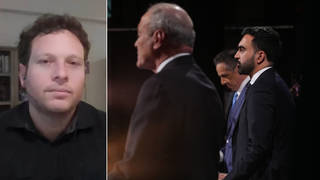
Guests
- Heather Ann ThompsonAmerican historian, author and activist. She is the author of the Pulitzer Prize-winning book Blood in the Water: The Attica Prison Uprising of 1971 and Its Legacy. She is a professor of history at the University of Michigan in Ann Arbor.
- Amani Sawariprison strike organizer working on behalf of Jailhouse Lawyers Speak, a network of prisoners who are helping organize the nationwide strike.
Prisoners in at least 17 states are expected to strike today in a mass mobilization demanding improved living conditions, sentencing reform, the right to vote and the end of “prison slave labor.” The weeks-long strike begins on the 47th anniversary of the killing of Black Panther George Jackson, who was shot and killed by guards during an escape attempt from San Quentin prison. It will end on September 9, the 47th anniversary of the deadly Attica prison uprising. For more, we speak with Heather Ann Thompson, American historian, author and activist. She is the author of the Pulitzer Prize-winning book “Blood in the Water: The Attica Prison Uprising of 1971 and Its Legacy.” She is a professor of history at the University of Michigan in Ann Arbor. We also speak with prison strike organizer Amani Sawari.
Transcript
AMY GOODMAN: This is Democracy Now!, democracynow.org, The War and Peace Report. I’m Amy Goodman. Prisoners across the country set to go on strike today in a mass mobilization demanding improved living conditions, greater access to resources and an end to what they call “modern day slavery.” Prisoners in at least 17 states expected to participate in the strike, coordinating sit-ins, hunger strikes, work stoppages, commissary boycotts, from today until September 9th—the 47th anniversary of the deadly Attica uprising.
In addition to our guests Cole Dorsey and Amani Sawari, who are both prisoner strike organizers, I want to bring into this conversation Heather Ann Thompson, American historian, author and activist. She just wrote the Pulitzer Prize-winning book Blood in the Water: The Attica Prison Uprising of 1971 and Its Legacy.
Professor Thompson, can you talk about the timing of this strike? It’s soon after Lee, that happened a few months ago, the prison uprising that led to seven prisoners killed, at least, but this 47th anniversary today of the killing of George Jackson at San Quentin to September 9th, the beginning of the Attica uprising here in New York. Professor Thompson?
HEATHER ANN THOMPSON: Well, I mean, as the previous guests have noted, Lee was a really serious wake-up call, not so much for people on the inside—they were well aware of how catastrophic conditions were—but certainly for the outside. It was a real wake-up call just how barbaric the conditions are and that people on the inside needed to stand together to resist the overcrowding, the terrible medical care, the inability to ever get out because of the draconian laws that put them there.
And the choice of August 21st, which was the death of George Jackson, is also significant, because it was really indicative, then in 1971 and today, that part of being sentenced to time in prison in this country is to risk death, to risk death at the hands of guards, to risk death because of the brutal system, the lack of medical care. So, I think the choice to begin this nationwide resistance to the conditions inside being George Jackson’s death was deeply significant. And I think that also tying it to the Attica rebellion is so important, because, of course, the Attica brothers, back 47 years ago, even though they were in New York and George Jackson was killed in California, they heard about it immediately and were moved to stand together to resist the conditions, that were brutal then and have gotten even more so in the subsequent decades.
AMY GOODMAN: Well, explain more that history, especially for young people who certainly weren’t even alive at that time, that it happened on the same day, George Jackson, his killing at San Quentin by guards, and Attica in New—the same year, a few weeks apart, and then right after that, Attica.
HEATHER ANN THOMPSON: Right. Well, certainly for the men inside of Attica, who had been, like the men in California’s prisons, enduring terrible medical conditions, lack of decent food, abusive guards—all of the same things that we see today—back in 1971, when George Jackson was killed and word traveled to Attica, people went to the mess hall that morning in utter silence, wearing black armbands, to really stand and recognize the significance of Jackson’s death. Jackson was significant because he had been writing from prison to the world, telling everyone what these conditions were like. And not too much after that, not too much longer after that, the Attica men stood together—1,300 of them stood together—again, like today, across differences of religion, across racial lines, and they told the state of New York that they needed to have better conditions inside of the New York state prisons. That, unfortunately, was ended extremely brutally by the state of New York—many people killed, many people tortured.
But what this really shows us today is that no matter how severe the repression, people will stand together as human. They will continue to stand together. And I think it’s really significant that in 2016 we saw thousands and thousands of prisoners stand up, and again, today, we are seeing more. It will be interesting to see how many we will actually know about right away. The repression inside is severe, and everyone will have to make their own choices as to whether or not they can be public about what they’re doing. But I think that behind bars right now, in a way that we’re not even aware of, there’s a whole lot of people standing together to let us know that this system is severely broken and we’ve got to change.
AMY GOODMAN: Amani Sawari, you’re on the outside. How did you get involved with organizing this strike? And what do you think people on the outside can do?
AMANI SAWARI: So, the way that I got involved was actually through Twitter. One of the jailhouse lawyers reached out to me, direct message, and asked if they could host the strike on my website, SawariMi.org. And I was happy to do so. And there is where the demands were posted, after they had put them out on Twitter originally. And then there is also where the list of endorsements, which is businesses and organizations—there are about a little over 200 right now, throughout the country, that are saying, “We’re behind this. We’ll do what we can to support.” There is also where the news and press releases are collected. So, that is how I got involved. After accepting that request via Twitter, I talked to one of the jailhouse lawyers on the phone, and he let me know why they were doing this. They originally had planned to do this in 2019. But after Lee had happened, they expedited the date and brought it up to 2018, so that they could have a direct response to what happened.
And then, what people can do on the outside is really find—we have a list of events on It’s Going Down, as well as SawariMi.org, around the country that are happening. Just show up at one of those events. We’re going to have marches. We’re going to have protests, pickets in front of businesses that use prison slave labor. That’s another thing that people can do, is be really intentional about where they’re spending their money. Our dollar is our vote in this system, and when we choose to buy clothes or fast food or get our insurance or our gas from places that participate in prison slave labor, then we are fueling that system and allowing it to persist. But when we choose to just make that alternative choice, then we can really suffocate that system. And prisoners are doing that. They have to do that when they boycott. All the money that they spend goes towards the prison, so they’re not allowed to get any of those privileges. But we could just make the simple choice of just making that alternative. They have no alternative. So if they can do it, we can definitely support them by doing the same out here.
AMY GOODMAN: Heather Ann Thompson, in the last minute we have, can you talk about the repression and retaliation prisoners face if they were to participate in this strike?
HEATHER ANN THOMPSON: Well, it can be severe. And I really—I think we should really heed Amani’s point that support on the outside is critical. Eyes on what’s happening on the inside is critical. One of the things that Attica shows us is not just that it’s important to support folks when they’re protesting on the inside in the moment when they’re protesting, but to keep eyes on this throughout. It’s really—
AMY GOODMAN: And how do people keep eyes on it?
HEATHER ANN THOMPSON: It’s highly likely that there will be folks that will experience some serious retaliation from prison management, and we’ve got to watch what’s going on, demand entry, provide lawyers and make sure that folks on the inside are protected.
AMY GOODMAN: Well, I want to thank you all very much for being with us. Heather Ann Thompson is the Pulitzer Prize-winning historian. Her book is about Attica, the book called Blood in the Water: The Attica Prison Uprising of 1971 and Its Legacy. Amani Sawari, speaking to us from Seattle, Washington, prison strike spokesperson. And Cole Dorsey was on the inside, now on the outside, one of the prison strike organizers. He’s speaking to us from Oakland, California. And, of course, we will continue to cover this strike that’s expected to go on until September 9th.
That does it for our show. We have a job opening for a broadcast engineer, full-time. Find out more at democracynow.org and apply.











Media Options